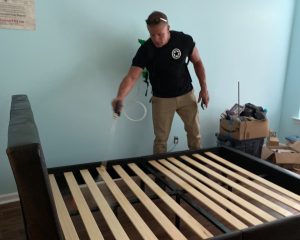
Spring is here, and so are the pests—but this year, things seem to be a little different. As the weather warms up, pest patterns are shifting, and infestations are taking on new forms. From the types of insects that are becoming more common to the areas they’re targeting, it’s clear that the spring pest season is evolving.
If you’ve noticed more ants marching through your kitchen or an increase in critters around your home, you’re not alone. The changing climate is having an impact on pest behavior, making it more important than ever to stay ahead of the game when it comes to pest control.
How do shifting weather conditions influence spring pest activity?
Shifting weather conditions significantly influence spring pest activity by altering their behavior, migration patterns, and breeding cycles. Here’s how changing weather affects pest activity:
- Warmer Temperatures: Rising temperatures in spring awaken dormant pests, such as ants, termites, and mosquitoes, triggering increased activity. Warmer weather encourages these pests to emerge from hibernation, forage for food, and seek shelter, often leading to infestations around homes and buildings.
- Increased Rainfall: Heavy spring rains create favorable breeding grounds for pests like mosquitoes and ticks. Standing water in puddles, clogged gutters, and damp environments become breeding sites, leading to higher populations of these pests. The excess moisture also encourages mold growth, which attracts pests such as ants and cockroaches.
- Milder Winters: Milder winters result in fewer pest die-offs, allowing insects and rodents to survive the colder months. As a result, pest populations can be larger and more widespread in spring, creating a heightened risk for infestations. For example, rodents may move indoors seeking warmth and food after a mild winter.
- Fluctuating Humidity: Changes in humidity levels during spring can affect pests like termites and cockroaches, which thrive in moist conditions. High humidity increases their activity and likelihood of invading homes to find more stable environments.
Shifting weather conditions in spring directly impacts pest activity by creating more favorable breeding, feeding, and sheltering environments. This leads to an increase in infestations and potential damage to homes.
Why are some pests appearing earlier in the season than usual?
Some pests appear earlier in the season than usual due to various environmental and climatic factors that change their natural life cycles. Here’s why this is happening:
- Warmer Winters: Milder winters, resulting from climate change, allow pests such as ants, termites, and mosquitoes to survive the colder months. Without a hard frost to kill off dormant insects, they remain active or hibernate in sheltered environments, leading to earlier emergence as the temperature warms up.
- Higher Spring Temperatures: Rising spring temperatures bring about an earlier awakening for many pests. As temperatures climb, insects like flies, beetles, and ticks become active sooner, seeking food and breeding opportunities earlier than they would have in the past.
- Increased Rainfall and Moisture: Excessive rainfall and increased moisture create ideal breeding conditions for pests such as mosquitoes, cockroaches, and termites. Standing water in puddles or clogged gutters provides a prime environment for these pests to breed, causing them to appear earlier in the season.
- Extended Growing Seasons: Longer growing seasons due to shifting weather patterns encourage plants to bloom earlier, providing food sources for pests like aphids and moths. These pests are attracted to the early availability of vegetation, speeding up their seasonal arrival.
Changes in climate and weather patterns are causing pests to appear earlier than usual, making it more challenging to predict and control infestations.
What factors contribute to the rise of unexpected infestations during spring?
Several factors contribute to the rise of unexpected infestations during the spring season. These factors create ideal conditions for pests to thrive and invade homes, often leading to surprise infestations. Here’s what drives this increase in pest activity:
- Mild Winter Weather: Warmer winter temperatures allow pests such as rodents, termites, and insects to survive the colder months. Without the usual cold snap to kill off dormant pests, these creatures emerge earlier in spring, resulting in larger populations and a higher likelihood of infestations.
- Increased Rainfall: Heavy rainfall and spring storms provide an abundant water source for pests like mosquitoes, termites, and ants. Standing water in puddles, ponds, and even clogged gutters serves as a breeding ground for these pests, encouraging their rapid growth and spreading to nearby homes.
- Rising Temperatures: As temperatures rise, insects and pests that stay dormant during the colder months become active. For example, ants begin foraging for food, mosquitoes emerge to breed, and rodents look for shelter and food sources, leading to an increase in unexpected infestations.
- Spring Plant Growth: Early blooming plants provide food sources for pests like aphids, moths, and caterpillars. This surge in available vegetation attracts pests that move into homes or nearby areas.
- Nesting Behavior: Many pests, including rodents, seek warmer environments for spring nesting. With homes often providing the perfect shelter, infestations can begin unexpectedly as pests search for safe spaces to breed.
Weather changes, food availability, and shelter-seeking behavior increase pest activity during spring, causing infestations to appear unexpectedly in homes and gardens.
How are local ecosystems being affected by changing spring pest patterns?
Changing spring pest patterns significantly impact local ecosystems, as shifts in pest populations affect both natural habitats and human environments. Here’s how local ecosystems are being affected:
- Disruption of Food Chains: Pests like mosquitoes, aphids, and caterpillars are critical food sources for predators, including birds, amphibians, and insects. As pests appear earlier or in larger numbers, it disrupts the natural timing of food availability for these predators. This shift can lead to mismatches in the food chain, affecting predator populations and overall ecosystem balance.
- Invasive Species Proliferation: Some pests, such as termites and certain types of ants, are invasive species that can damage local vegetation and structures. Early pest activity and expanding populations may increase the spread of these non-native species, disrupting local plant and animal populations by outcompeting native species for resources.
- Pollution and Plant Health: Pests like aphids and certain beetles can harm local plant life by feeding on leaves, stems, and roots. The earlier arrival of these pests may cause local vegetation to suffer, leading to weaker plants and decreased biodiversity. This has a cascading effect on other species dependent on healthy plants for food and shelter.
- Health Impacts on Wildlife: The earlier emergence of pests like ticks and mosquitoes can spread diseases such as Lyme disease or West Nile virus, affecting local wildlife populations. These diseases can weaken animal populations and impact biodiversity.
The changing patterns of spring pests are disrupting local ecosystems by altering food availability, increasing the spread of invasive species, damaging plant health, and introducing health risks to wildlife.
Don’t Let Pests Take Over—Take Control Today!
Pests aren’t following the same old patterns this spring, and it’s making infestations harder to predict. With climate changes and new pest behaviors, staying on top of prevention is more important than ever. If you’re noticing more critters around your home, it’s time to take action before they settle in for good.
At Freedom Pest Services, we’re here to help you tackle the changing pest landscape with expert solutions. Our team understands the latest pest patterns and will work with you to protect your home from unwanted guests. Reach out to us today and let’s keep your space pest-free all season long.
